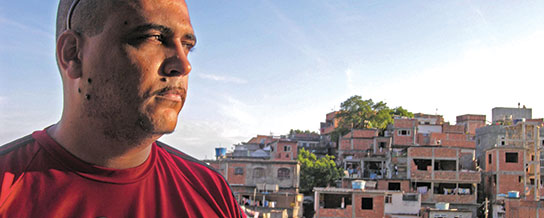Sany Pitbull: Baile Funk’s Future
In the last five years, baile funk, long neglected and shunned by the Brazilian press […]

Sany Pitbull: Baile Funk’s Future
In the last five years, baile funk, long neglected and shunned by the Brazilian press […]

In the last five years, baile funk, long neglected and shunned by the Brazilian press and the Rio de Janeiro elite, has become an established music genre worldwide.
While there’s no question baile funk can move a dancefloor, it has been criticized for a certain lack of depth; a lot of productions use the same sounds, usually the omnipresent (and relatively new) tamborzão beat or samples from the days when Kraftwerk and Afrika Bambaataa were the genre’s major influence. Even DJ/producer extraordinaire Sany Pitbull–the maestro, as he’s known to his peers–agrees that it’s time for baile producers to try a little harder.
“We have this romantic idea that we are ‘magical’ artists, that we are born ready!” says Sany poetically. “But without study and hard work, musicians–as much as a construction worker or a lawyer–can have all the talent in the world and they will always be missing something.”
With his own label, Carioca Funk Clube, Sany is freeing the music from a lot of the rules it has imposed on itself. Meanwhile his party, which also bears the label’s name, is freeing funk events, often held in gang-controlled favelas, from their violent connotations. The club night–where acts like Phabyo DJ, Ba$$ Comando, and DJ Juninho perform–is described by Sany’s partner Adriana Pittigliani as a “neutral zone to hear and practice baile funk, far from [criminal] factions or marketing rules.”
Although Sany transforms The White Stripes’ “Seven Nation Army,” Guns ‘N’ Roses’ “Sweet Child O’ Mine,” and Nirvana’s “Come As You Are” into baile funk anthems for his live performances–which involve him going frenetic on a turntable and an MPC–his production work shows a great deal more innovation. Sany’s EP for the Baile Funk Masters series, released through Germany’s Man Recordings, is a milestone for the genre. It boasts new textures, moods, and sound sources–from the construction noises used to build “Funk Alemão” (“German Funk”) to the Japanese gongs in “Tribos” to the Western-influenced “Faroeste.”
Another major change is that the vocals have been minimized, putting more emphasis on the beats themselves. This post-baile funk style is closer to the club music that many Europeans and Americans have been making, but with Brazilian flavor. “There’s still a huge difference when [funk] music is made by [an actual] baile funk producer from Rio, as long as he studies a little beyond the limitations of the past,” says Sany.
And, as far as he’s concerned, things can only get better: “People from all over the world are listening to [the music]; that’s the biggest change. I see the future of baile funk much as I saw it in the beginning, with lots of happiness and fun and freedom, but maybe with a little less social separation and some more hard work.” Hardly a surprising statement, coming from baile funk’s biggest workaholic.
XLR8R Exclusive: Sany Pitbull Hand-Drawn Illustrations
click to enlarge
click to enlarge

